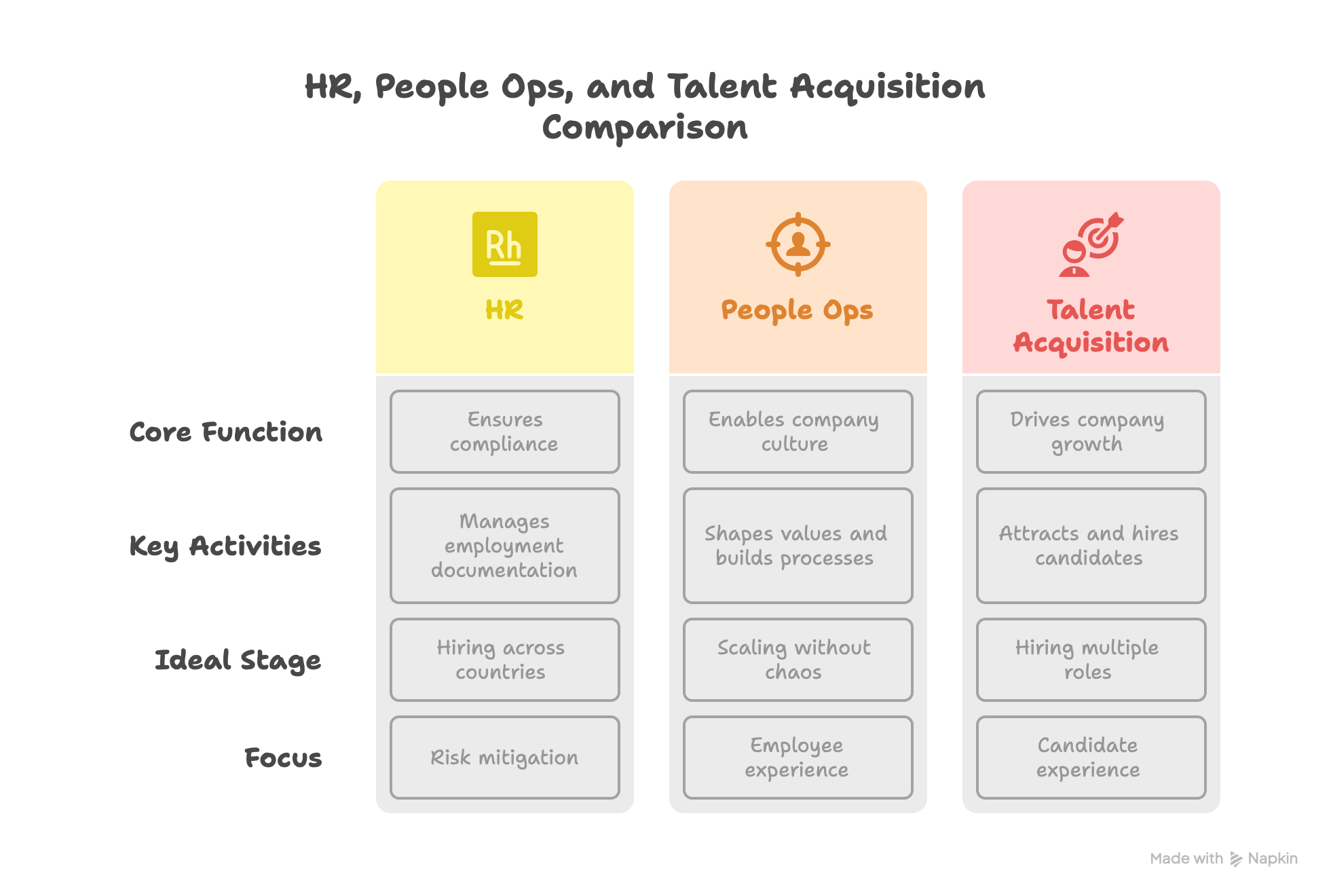🧩 HR vs People Ops vs Talent: What’s the Difference (and What You Need First)
You’re building your team — but who should actually run it?

Is it HR?
Is it People Ops?
Is it Talent Acquisition?
For most startup founders, these terms blur into one — until the wrong hire slows you down, or the right hire saves you months.
This article clears up the confusion, shows what each function really does, and helps you decide what to prioritize first.
🧠 Why It Matters
Founders often make one of these mistakes:
- Hiring an HR generalist when they actually need strategic recruiting
- Expecting a People Ops lead to handle employer branding and sourcing
- Hiring “Head of Talent” too early when they really need structure and compliance
Confusing the roles leads to misaligned hires, burned budget, and gaps in team experience.
🔍 The 3 Functions — Clear and Simple
FunctionFocus AreaKey Activities
HR
Administration & compliance
Payroll, benefits, contracts, leave tracking, internal policies
People Ops
Team experience & performance
Onboarding, feedback, engagement, culture design, learning & development
Talent
Recruiting & attraction
Sourcing, employer branding, interviewing, hiring funnel design
Let’s break each one down.

🧾 HR: Your Compliance Backbone
Think of HR as the foundational layer.
- Ensures contracts and labor laws are correct
- Manages payroll, benefits, and employment docs
- Handles risk, legal, and internal documentation
You need this when:
- You’re hiring across countries
- You want to stay compliant
- You’re scaling from 5 → 20+
But HR ≠ culture. HR ≠ hiring strategy. That’s where People Ops and Talent come in.
🧠 People Ops: The Culture Enabler
People Ops designs how people experience work — from onboarding to exit.
- Shapes values, rituals, and clarity
- Builds processes that scale (feedback, reviews, L&D)
- Improves retention and performance through systems
You need this when:
- You have 10+ employees and want to scale without chaos
- You’re hearing “we don’t know what’s expected”
- Top performers start to disengage
Good People Ops feels invisible — but it enables everything.
🎯 Talent: The Growth Driver
Talent Acquisition isn’t just “recruitment.” It’s how you sell your company to future teammates.
- Writes job descriptions that attract the right people
- Sources passive candidates
- Runs structured, fast interview loops
- Drives offer close and candidate experience
You need this when:
- You're hiring 3+ roles in 6 months
- You’re losing candidates mid-funnel
- Your interviews feel inconsistent or slow
💡 What Should You Prioritize First?
Early-stage startups (2–15 people):
- HR admin (even fractional or outsourced)
- Talent — to get the right people on board
- People Ops — to help them thrive
Growth-stage (15–50):
Start integrating People Ops into the org — rituals, performance, clarity.
Beyond 50:
All three functions become essential. Often handled by different people or partners.
✅ Quick Framework: “What’s Your Pain?”
🛠️ Modern Approach: Blended or Embedded Support
You don’t need three full-time hires.
Startups increasingly rely on embedded partners who bring all three lenses — recruiting, people design, and HR basics — in a right-sized, strategic way.
UnitiQ’s model supports exactly this.
🔁 Related Reading
🔚 Final Thought
Great startups know what they’re building — and who they need to build it.
Don’t lump People Ops into HR. Don’t expect your HR admin to run Talent.
Get clear. Then build accordingly.
About Author
Olga Fedoseeva is an award-winning HR executive and people strategist with over 20 years of international experience across EMEA, the US, and APAC. Currently Chief of Staff at Exponential Science and Founder of UnitiQ, she has personally hired more than 1,000 employees and scaled organizations from 30 to 3,000 staff. Recognized as one of the Top HR Women in EV (2021), Olga has led global HR transformation, talent acquisition, and people operations for startups, scale-ups, and multinational enterprises. Her expertise spans the full HR lifecycle—succession planning, DEI, HR tech integration, workforce planning, and executive coaching—helping businesses align people strategies with growth objectives while fostering inclusive, high-performance cultures.
